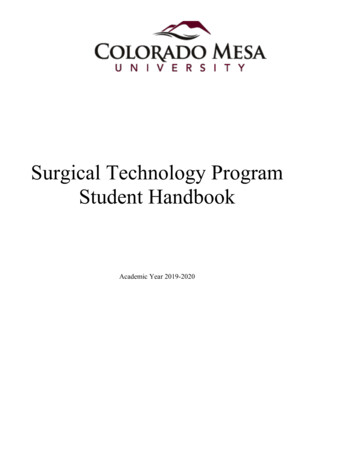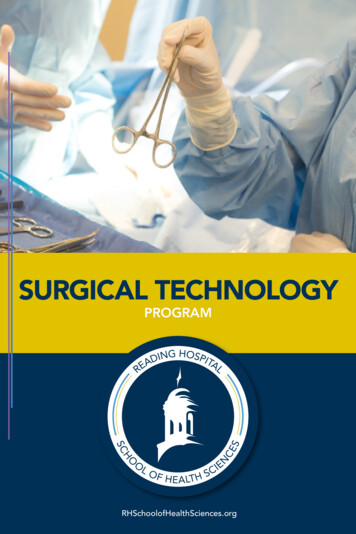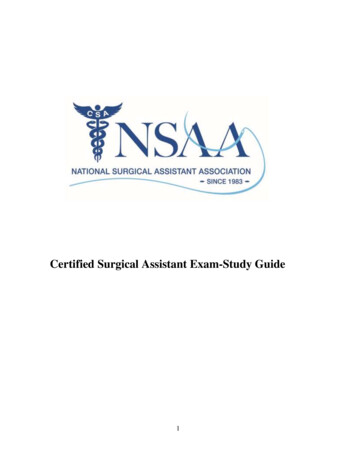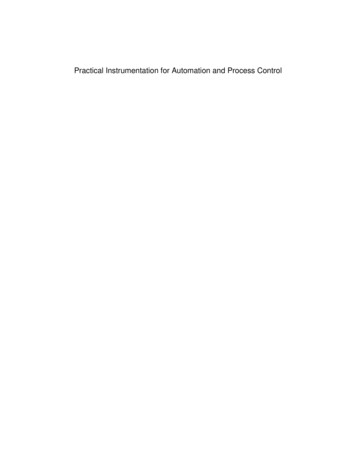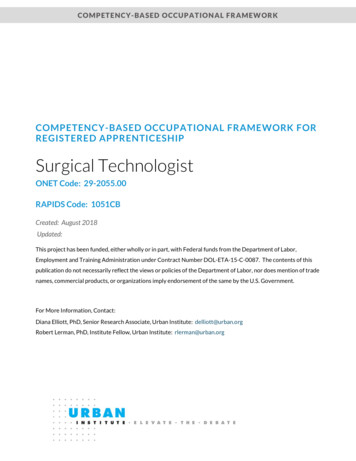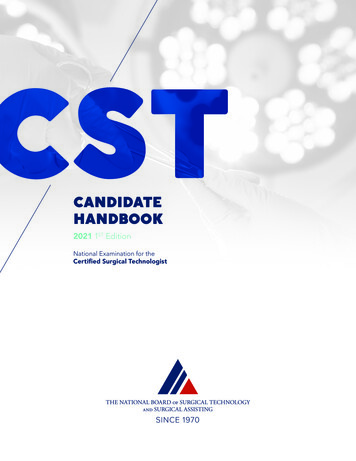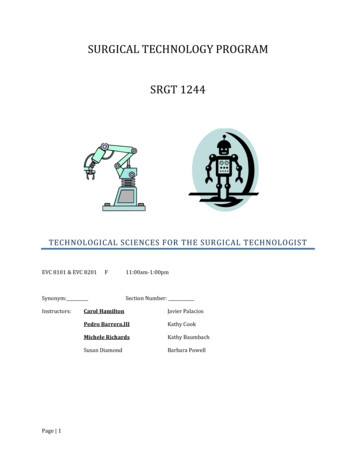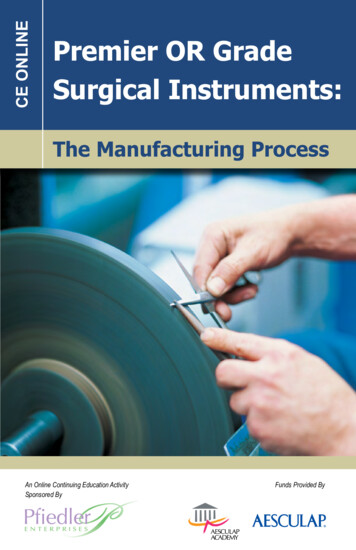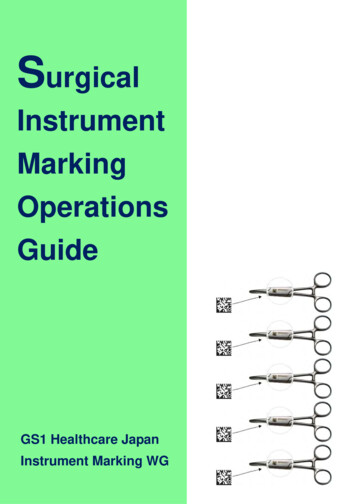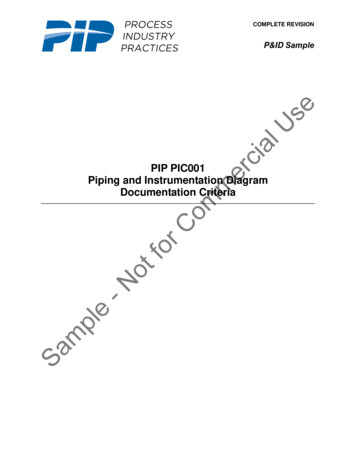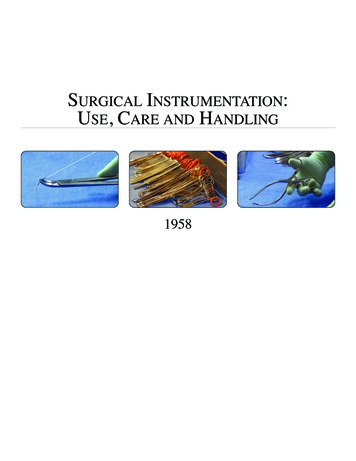
Transcription
SURGICAL INSTRUMENTATION:USE, CARE AND HANDLING1958
1958SURGICAL INSTRUMENTATION: USE, CARE AND HANDLINGSTUDY GUIDEDisclaimerAORN and its logo are registered trademarks of AORN, Inc. AORN does not endorse any commercial company’s products orservices. Although all commercial products in this course are expected to conform to professional medical/nursing standards,inclusion in this course does not constitute a guarantee or endorsement by AORN of the quality or value of such products or ofthe claims made by the manufacturers.No responsibility is assumed by AORN, Inc, for any injury and/or damage to persons or property as a matter of product liability,negligence or otherwise, or from any use or operation of any standards, recommended practices, methods, products, instructions,or ideas contained in the material herein. Because of rapid advances in the health care sciences in particular, independentverification of diagnoses, medication dosages, and individualized care and treatment should be made. The material containedherein is not intended to be a substitute for the exercise of professional medical or nursing judgment.The content in this publication is provided on an “as is” basis. TO THE FULLEST EXTENT PERMITTED BY LAW, AORN,INC, DISCLAIMS ALL WARRANTIES, EITHER EXPRESS OR IMPLIED, STATUTORY OR OTHERWISE, INCLUDINGBUT NOT LIMITED TO THE IMPLIED WARRANTIES OF MERCHANTABILITY, NON-INFRINGEMENT OF THIRDPARTIES’ RIGHTS, AND FITNESS FOR A PARTICULAR PURPOSE.This publication may be photocopied for noncommercial purposes of scientific use or educational advancement.The following credit line must appear on the front page of the photocopied document:Reprinted with permission from The Association of periOperative Registered Nurses, Inc.Copyright 2012 “Surgical Instrumentation: Use, Care, and Handling.”All rights reserved by AORN, Inc.2170 South Parker Road, Suite 400,Denver, CO 80231-5711(800) 755-2676 www.aorn.orgVideo produced by Cine-Med, Inc.127 Main Street North, Woodbury, CT 06798Tel (203) 263-0006 Fax (203) 263-4839www.cine-med.com2
S URGICAL I NSTRUMENTATION : U SE , C AREANDH ANDLINGSurgical Instrumentation: Use, Care and HandlingTABLE OF CONTENTSPURPOSE/GOAL/OBJECTIVES.4INTRODUCTION .5MANUFACTURING PROCESSES .5Stainless Steel .5Titanium.5Vitallium .5Other Metals .5Instrument names.6TYPES OF SURGICAL INSTRUMENTS .6Cutting and Dissecting Instruments.6Powered Cutting Instruments .8Clamping and occluding instruments .8Grasping and Holding Instruments.10Exposing and Retracting Instruments.10Suturing and stapling instruments.11Accessory Instruments.12ENDOSCOPIC (MINIMALLY INVASIVE) INSTRUMENTS .13INSTRUMENT CARE AND HANDLING ON THE STERILE FIELD .14INSTRUMENT CARE AFTER g.16Endoscope Cleaning .16Laparoscopic Instruments.16Powered Surgical Instruments .18SPECIAL PRECAUTIONS .19Ophthalmic Instruments .Prion Diseases.PERSONAL PROTECTIVE EQUIPMENT (PPE).19SUMMARY.19REFERENCES .20POST-TEST .21POST-TEST ANSWERS .243
S URGICAL I NSTRUMENTATION : U SE , C AREANDH ANDLINGPURPOSE/GOALThe purpose of this study guide and accompanying video is to provide information to perioperative staff members on the use,care and handling of all surgical instruments including minimally invasive, powered and endoscopic instruments.OBJECTIVESAfter viewing the video and completing the study guide, the participant will be able to:1)2)3)4)5)6)State the principles of instrument care.Describe the four major categories of surgical instruments.Name the basic components of powered instruments.Discuss special considerations for endoscopic instruments.Discuss intraoperative instrument handling including proper passing techniques.Describe the proper cleaning required for each category of instrument.4
S URGICAL I NSTRUMENTATION : U SE , C AREINTRODUCTIONH ANDLINGinstruments produced. It is important for perioperative staffmembers to know what each instrument is made of. The metalalloys used in surgical instruments must be resistant tocorrosion, which can result from exposure to blood, bodyfluids, cleaning solutions, sterilization, and the atmosphere.Surgical instruments arehigh quality tools that aredesigned for accomplishinga specific desired effectduring invasive procedures.Instruments are integralcomponents of all surgicalprocedures. Perioperative staff members must understand theuse, handling, and care of surgical instruments. Propercleaning and handling minimizes damage, increasesinstrument life expectancy, and protects instruments, whichare a major financial investment for facilities. Carefulplanning, preparation, and use of instruments will contributeto an efficient and effective surgical procedure within a safeenvironment.Stainless SteelInstruments made of stainless steel begin the manufacturingprocess with the conversion of raw steel into instrumentblanks. There are more than 80 different types of stainless steeland these are graded based on quality and composition. Themost common grades used for surgical instruments are the 300and 400 series grades and of those, the 400 series is morecommonly used. Instruments such as retractors and speculumsare generally manufactured from the 300 series, while cuttingand non-cutting instruments are made from the 400 series.TitaniumSurgical instruments perform basic functions such as holdingor retracting tissue; dissecting, cutting, or incising tissue; andassisting with suturing and or closure of the surgical incision.Most surgical instruments are made of stainless steel or othermetals. The metal selected must be easily cleaned, disinfected,and maintained.Titanium has excellent metallurgical properties for use inmicrosurgical instruments. The most notable and usefulproperties of titanium are that it is nonmagnetic and inert. Itis harder, stronger, lighter in weight, and more resistant tocorrosion than stainless steel.1Surgical procedures are becoming more complicated andintricate and as a result surgical instruments are becomingmore complex, more precise in design, and more delicate instructure. With the development of new tools, instrument careand handling becomes more challenging. There are currentlyhundreds of different types of surgical instruments and moreare being developed everyday as surgical procedures changeand evolve.VitalliumVitallium, the trade name for a cobalt/chromium/molybdenumalloy, is suitable for orthopedic devices and maxillofacialimplants because of its strength and corrosion-resistantproperties. Vitallium instruments must be used with vitalliumimplants to maintain electrolytic compatibility.1Other MetalsWhile most instruments are made of steel alloys, some aremade from brass, silver, or aluminum. Some cutting blades,tips, and jaws are laminated with tungsten carbide, which isan exceptionally hardened metal.1MANUFACTURING PROCESSESSurgical instruments are the surgeon’s tools. Each one isdesigned and carefully crafted for an intended surgicalpurpose. They must be durable and not prone to rusting,chipping, or denting with normal handling, which is why mostare made with stainless steel, a combination of carbon,chromium, iron, and a few other alloys (i.e., metals). Withadvances in modern technology, other materials such astitanium and vitallium, and other polymers are also used, butstainless steel continues to account for the majority ofAND5The cutting or drilling of instrument blanks is accomplishedby different methods, one of which is the precision blastingof the instrument blank sheath with garnet sand while it issubmerged in a bath of bubbling coolant. The cut needed isprogrammed into a computer that directs the cutting arm ofthe machine. The measurements are precise, sometimes withina fraction of an inch, to make sure the component parts fit andmeet in the exact manner needed. The machines designed toproduce surgical instruments meticulously follow thecomputerized engineering designs and warn the operator iferrors occur during drilling and cutting. When this process iscomplete, the raw steel material has become an instrumentthat is designed to do a particular job and function in aparticular manner.
S URGICAL I NSTRUMENTATION : U SE , C AREH ANDLINGhappening on the surgical field and knowing this progressionwill help the scrub person to anticipate which instrument willbe needed.The next step in the manufacturing process is providingcorrosion resistance. This is accomplished by the removal ofcarbon steel particles through immersion of the instrument intodiluted nitric acid. The final step is to polish the instrument. An incision is made using a cutting instrument, suchas a knife or scissors. Clamps or forceps may be usedto control superficial bleeding at this point.Electrosurgical energy delivered through an activeelectrode may be used to create hemostasis or toextend the excision. Cutting of internal tissue layers is accomplished withscissors. Exposure of the surgical field is made possible byretractors. Suction evacuation is used to eliminate the surgicalsmoke plume created by the electrosurgical unit andto suction fluid or blood from the surgical field.It is easy to see that surgical instruments can be classified intofour main categories:Manufacturers of surgical instruments add one of threefinishes during fabrication: satin (i.e., dull), highly polished,and ebonized. A highly-polished finish, increases resistance tocorrosion, but can affect the ability of the surgeon tosee because of light reflection. A satin finish is less reflective and reduces glare. An ebonized finish is black chromium, isnonreflective, and virtually eliminates glare.For most procedures, either satin or highly-polishedinstruments will be used. Ebonized instruments are typicallyused in laser procedures to prevent laser beam reflection offthe instrument.Instrument Names cutting and dissecting, clamping, grasping or holding, and exposing and retracting.A fifth category exists for other accessory instruments that donot easily fit into these main classifications. These will bediscussed later in this study guide.Surgical nomenclature lacks standardization, but willgenerally follow certain patterns. For example, instrumentsmay be named: by the action that the instrument is designed toperform (e.g., scissors, knife), to recognize the inventor (e.g., Debakey forceps), or a combination of how the instrument is to perform ina particular type of surgery and an inventor’s name(e.g., a Lambotte osteotome, a tool that is designed tocut bone, invented by Lambotte).Names of instruments also vary by the region of the countryin which they are used, the surgeon’s preference for a name,and the facility’s commonly used name.Cutting and Dissecting InstrumentsBasic cutting and dissectinginstruments, sometimesreferred to as “sharps,” doexactly what their nameimplies; they cut anddissect tissue or othermaterials. The useable partof the instrument has asharp or cutting edge. Cutting instruments include knives,scalpels, and scissors of all types and shapes.Because instruments represent a major financial investmentfor a facility, proper care and handling should be a primaryconcern for all personnel who work with instruments. Afterinstruments are received from the supplier, they should becarefully examined, cleaned, decontaminated, and sterilizedaccording to the manufacturer’s instructions before use in thesterile field.Knives and scalpelsThe words knife and scalpel are used interchangeably, butgenerally, a scalpel has a detachable, disposable blade andnondisposable handle, while the term knife refers to singleunit cutting device such as an amputation knife. The handlesize and configuration of scalpel handles varies toaccommodate the area of use. Knife blades may have curvededges or sharp, stabbing points. When using a knife, care mustbe taken to avoid injury to self or others.TYPES OF SURGICAL INSTRUMENTSMany different kinds of surgical instruments and tools havebeen invented over the years. Instruments may be designedfor general surgical use or for use during a specific procedure.Generally, there is a natural progression of instrument useduring a surgical procedure. Paying close attention to what isAND6
S URGICAL I NSTRUMENTATION : U SE , C AREPassing Knives and ScalpelsANDH ANDLINGmeet at the swivel (i.e., the point where the rivet or screwconnects the blades) and the cutting point.The blades of the scissors also must be sharp. Cutting anythingother than what the scissors were designed to cut (i.e., usingtissue scissors to cut suture) will dull the blades and result intheir misalignment. Routinely check to ensure that the bladesare sharp and that the screw joining them together has notloosened. This can be accomplished by holding the scissorshorizontally by one ring handle. If the blades open freely, thescissors need to be tightened. The two basic types of scissorsare: tissue and suture scissors.When required to pass a sharp item to the surgeon, AORN’sGuidance Statement: Sharps Injury Prevention in thePerioperative Setting calls for the use of a “neutral or handsfree technique whenever possible or practical instead ofpassing hand to hand.”2 A neutral zone is a designated area onthe sterile field where the scrub person and the surgeon placeall sharp instruments (including needles). If it is absolutelynecessary to pass a knife hand-to-hand, it should be heldcarefully between thumb and fingers and presented handlefirst to the surgeon with the cutting edge of the blade pointingdown and away from both of you.Tissue ScissorsTissue scissors are used for tissue dissection. Most tissuescissors have curved tapered points. Metzenbaum scissors areused to cut medium to delicate tissue while the sturdier Mayoscissors are used to cutheavy or thicker tissue orstructures such as fascia. AMetzenbaum scissors canbe distinguished from theMayo scissors by its narrowshaft and tips.Caution must be taken when loading or removing blades froma knife handle. Typically, an instrument such as a needleholder or clamp is used to hold the blade during removal.Many health care facilities provide disposable scalpels for useas a way to reduce the risk of injury and exposure to bloodborne pathogens.The curvature on the Metzenbaum and other tissue scissors isdesirable to surgeons because it facilitates the ability to seethe tips of the scissors during dissection and because they canreach around other structures. Small, fine scissors with sharptips (e.g., iris scissors, Castroviejo scissors), are used fordelicate ophthalmic or reconstructive surgery.ScissorsScissors are designed inshort, medium, long, andheavy lengths and may beblunt or sharp with straightor curved tips on theircutting edges. Scissorsconsist of a pair of metal blades connected in such a way thatthe edges of the blades cut materials placed between themwhen the handles are brought together. A conventionalscissors requires one movement to open the jaws and anotherto close them. Some scissors, particularly those used indelicate plastic and eye surgery, have a spring that holds thejaws open. Squeezing the handle together closes the bladesand relaxing of the grip opens them.When preparing for asurgical procedure, it isimportant to check thealignment of the scissorsblades. For scissors to cutsmoothly, the blades mustSuture ScissorsSuture scissors usually have straight blades and blunt points.Straight Mayo scissors are used primarily to cut suture.Angled bandage scissors can be used to cut bandages anddressings. Wire scissors should be used to cut wire and veryheavy sutures.Passing scissorsTo pass any curved instrument, including scissors, hold theinstrument at the joint and place the handle of the instrumentfirmly in the surgeon’s hand, in its position of use. The tips of7
S URGICAL I NSTRUMENTATION : U SE , C AREPowered cutting instrumentsareprecisiondevicesdesigned to make workingwith bone and cartilage easierand quicker than working byhand. They are used mostoften for precision drilling,cutting, shaping, and bevelingbone. There are many interchangeable attachments availablefor powered surgical hand pieces, and they are used in a widevariety of procedures. Some uses include:Other Cutting and Dissecting InstrumentsOther specialized cutting instruments include chisels, curettes,osteotomes, rasps, rongeurs, saws, and trephines. H ANDLINGPowered Cutting Instrumentsthe instrument should always be visible. Curved tips shouldpoint down. Gently snap or flip the wrist when placing theinstrument in the surgeon’s hand so the surgeon knows wherethe instrument is. This eliminates the need for the surgeon tostop and look for the instrument. Release the instrument assoon as the surgeon has a firm grip on it. ANDChisels are used to sculpt bone and have one bevelededge. A mallet is used in conjunction with a chisel.Curettes are used to scrape soft tissue or bone. Theyare manufactured with different size cupped ends andseveral angles and lengths. Uterine curettes are usedto scrape the endometrial lining of the uterus.Osteotomes are bone-cutting instruments used forshaping or marking bone. They have a double, bevelededge and come in several widths and are both curvedand straight in design. They may be used to removeperiosteum from bone. A mallet is used in conjunctionwith an osteotome.Rasps can be used to smooth rough bone surfaces orto evacuate the medullary canal in preparation forinsertion of an orthopedic prosthesis. They may besingle- or double-ended, with curved or taperedblades. Rasps may be forward- or backward- cutting,with fine or coarse teeth.Rongeurs are biting instruments used for cuttingtough tissue or bone. The biting cup comes in varioussizes and angles. When the surgeon squeezes thehandles together, the two sharp, cup-like ends cometogether to bite into the tissue and remove a smallsection. Rongeurs are most commonly used on bonesor heavy ligaments. They may be double- or singleaction.Saws include any notched blade used for cutting bone.Trephines are used to cut bone from the skull. Atrephine has a circular, sharpened edge. Drilling holes for placement of a metal plate to hold afracture together. This requires drill points, screws,and a screwdriver. Removing, reshaping, and reaming of bone at the kneeor hip joint for placement of a total joint prosthesis.This requires saw blades and drill bits of various sizesand shapes. Both forward and reverse speeds arenecessary for some of these activities.The first powered surgical instruments were powered byelectricity, air, or nitrogen under pressure stored in largeportable tanks. The electrically powered instruments weredifficult to maintain because the electrical cords deterioratedrapidly due to processing. For pneumatic instruments, apressure gauge controls the flow at a specified pounds persquare inch (PSI) pressure. Alternatively, compressed gas canbe piped directly into the operating suite. In this type ofsystem, a wall unit acts as the pressure gauge and controls theflow of gas, delivering a specific PSI. Special high-powerhoses connect the gas source to the handpiece of theinstrument. Surgeons found these pneumatic hoses unwieldywhich promoted the development of battery-operated surgicalinstruments, that have now become commonplace. After use,the battery pack is recharged and is sterilized immediatelybefore the powered instrument is used.3Clamping and Occluding InstrumentsSurgical clamps can be used to either compress or grasp astructure. They can be either occluding or nonoccluding (alsoreferred to as crushing or non-crushing). The types of clampsneeded for a particular procedure will depend on the kind oftissue to be held (i.e., delicate or tough) and the depth of thesurgical procedure (i.e., near the surface or deep). Hemostatsand occluding clamps should never be used to attach items tothe surgical drapes because this could bend their tips and strainthe box lock, making the instrument unsafe to use on tissue.8
S URGICAL I NSTRUMENTATION : U SE , C AREHemostatsANDH ANDLINGAllis clamps also allow grasping and holding withoutcrushing. They have multiple, tiny, fine teeth thatcurve slightly inward. Allis clamps will hold slightlyheavier tissue than Babcock clamps because they haveserrations along their edges. Kocher clamps are easily identified by the transverseserrations and the large teeth at the tips. This enablesthe surgeon to grasp and tightly hold heavy, tough, orslippery tissue such as fascia, bone, and cartilage. TheKocher is also known as an Ochsner clamp.Other types of clamps include hemostatic clips that may beloaded singly onto an applier or may come as a preloaded,disposable unit. These clips come in multiple sizes and theclip appliers are available in long and short lengths. These willbe covered in more detail under “Suturing and StaplingInstruments.” Hemostats are the mostcommon of all clampinginstruments. They are usedto grasp bleeding vesselsand prevent blood loss withminimal tissue damage.Hemostats range in sizefrom short to long and fromdelicate to heavier in design. They can be straight or curved.Examples of hemostats are the mosquito, Kelly, and Crile.Mosquito clamps are used to control surface bleedersand handle delicate tissue (e.g., plastic surgery handsurgery); Kelly clamps are used to control bleeders in muscletissue, to pass drains, and to hold Kitner or peanutsponges; and, Crile clamps are used to control bleeders insubcutaneous tissue.Perhaps the most important design feature of a hemostat is thejaw portion between the box lock and the tip. Some hemostatsare very slender and tapered to a fine point; others are thicker,with more blunt tips. The inside surfaces have deep groovesor serrations, which may go from side to side or runlongitudinally in the same direction as the jaws. Theseserrations allow bleeding vessels to be compressed withsufficient force to stop bleeding. The serrations must becleanly cut and perfectly meshed to prevent the tissue fromslipping free from the ends of the clamp. A general rule of thumb for selecting a clamp is to use delicateclamps for delicate tissue, heavy clamps for heavier or toughertissue. This concept can also be applied to the depth of thesurgical procedure; shorter clamps for superficial areas, longerclamps when working deep within a cavity. Another conceptto note is that finer clamps should be used on smaller vesselsand heavier clamps on thicker structures.Anatomy of a clampOccluding clampsOccluding clamps are usedto occlude or constricttissue and to clamp or graspbowel, ducts, and otherstructures with lumens.These instruments are usedto apply pressure. Theytypically have vertical serrations or special jaws with finelymeshed, multiple rows of longitudinally arranged teeth. Theyfunction to prevent leakage and minimize trauma to vesselsthat are to be reanastomosed. Examples of occluding clampsare Babcock, Allis, and Kocher clamps. Babcock clamps have curved fenestrated tips withoutteeth. They are used to grip or enclose delicatestructure such as bowel, appendix, ureters, or fallopiantubes. The smooth edges and bowed shape allowgrasping without penetrating, crushing, ortraumatizing tissue.The two parts of a clamp fit together at a box lock which,when closed or clamped together, remains locked until theratchets are released.The easily identifiable parts of a clamp are: 9The point of the tip which, when closed, should fittightly together unless it is designed to only partiallycompress tissue.The jaws of the instrument are either smooth or areserrated to hold tissue securely.The box lock is the hinge point of the instrument tipand handle.
S URGICAL I NSTRUMENTATION : U SE , C ARE Sponge forceps have ring-shaped jaws and are usedto hold gauze sponges which are then used forretraction, blunt dissection, or to absorb blood fromthe surgical field. Sponge forceps may be straight orcurved. Examples of these are Fletcher sponge forcepsand sponge sticks. Towel forceps are typically used to attach and securedraping material but also may be used to hold cartilageor scar tissue or to apply traction. They are availablein perforating and nonperforating varieties. Tenacula have sharp points that are used to penetrateand grasp tissue firmly. An example is a uterinetenaculum that is used to manipulate the cervix of theuterus.1 Tenacula may be single- or multitoothed.Other grasping and holding instruments include stone forcepswhich are used to grasp calculi (e.g., kidney or gallstones).Passing clampsRefer to the preceding section on Passing Scissors. Ensure thatthe clamp is closed and locked (if applicable). The tips andcurve of the instrument should always be visible.GRASPING AND HOLDING INSTRUMENTSGrasping or holding instruments allow the surgeon to dissectand suture tissue without causing injury. Forceps and somevarieties of clamps are referred to as grasping instrumentsbecause of how they perform.Forceps, or pickups as they aresometimes called, are two-bladed,tweezer-like instruments that aredesigned to pick up, grasp, andhold tissue to facilitate dissectionor suturing. There are manyvarieties of tips available onforceps. The selection of forceps depends on the intended use. H ANDLING The shank is the area between the box lock and thefinger rings.The ratchet is part of the finger ring handle andinterlocks to keep the clamp shut when the instrumentis closed. ANDPassing forcepsThe scrub person should grasp the top of the instrument wherethe two arms meet, and with the points down, pass it to thesurgeon allowing the surgeon access to the full length of theinstrument to adjust his or her grasp. Clamp-type forcepsshould be passed as stated above under Passing ClampsEXPOSING AND RETRACTING INSTRUMENTSSmooth forceps have simple serrations andsmooth, tapered points for use on delicate tissue.Examples of smooth forceps include Adsonforceps and Cushing or bayonet forceps.These instruments are used for two major purposes: to hold open the incision to provide exposure of thesurgical site, and for holding back surrounding organs and tissue tofacilitate the surgeon’s ability to see during theprocedure.Retractors come in many different sizes and shapes. Retractorsare referred to as either hand-held or self-retaining. Smallertypes can be held by the fingers or hands to retract skin andsubcutaneous tissue in shallow surgical areas while larger,heavier types may be self-retaining and are used to retractmuscle tissue and organs in deeper surgical sites.Toothed forceps may be either single-toothed orhave multiple teeth that interlock. These areused on dense structures such as tough skin,fascia o
the instrument. Instrument Names Surgical nomenclature lacks standardization, but will generally follow certain patterns. For example, instruments may be named: by the action that the instrument is designed to perform (e.g., scissors, knife)
